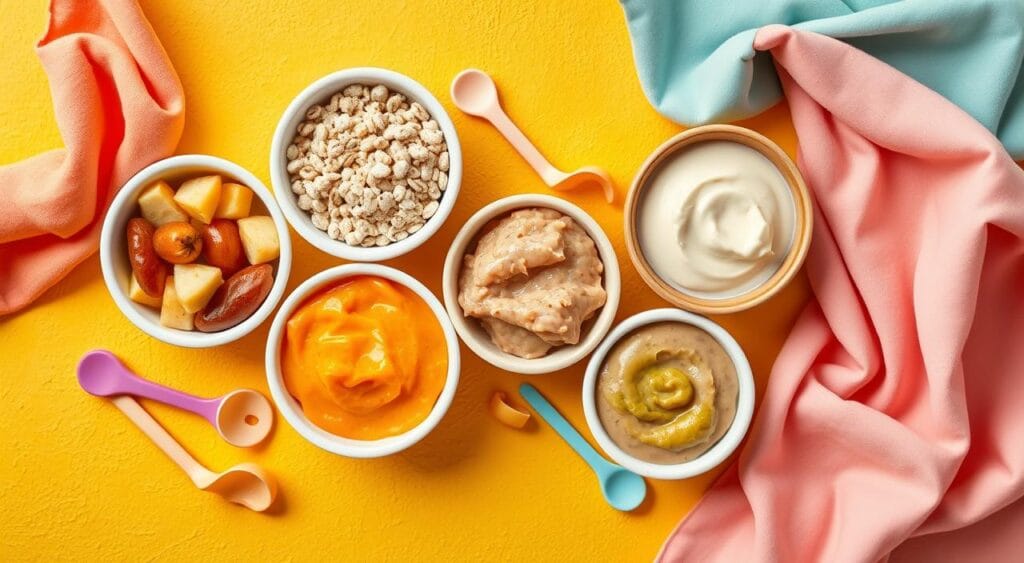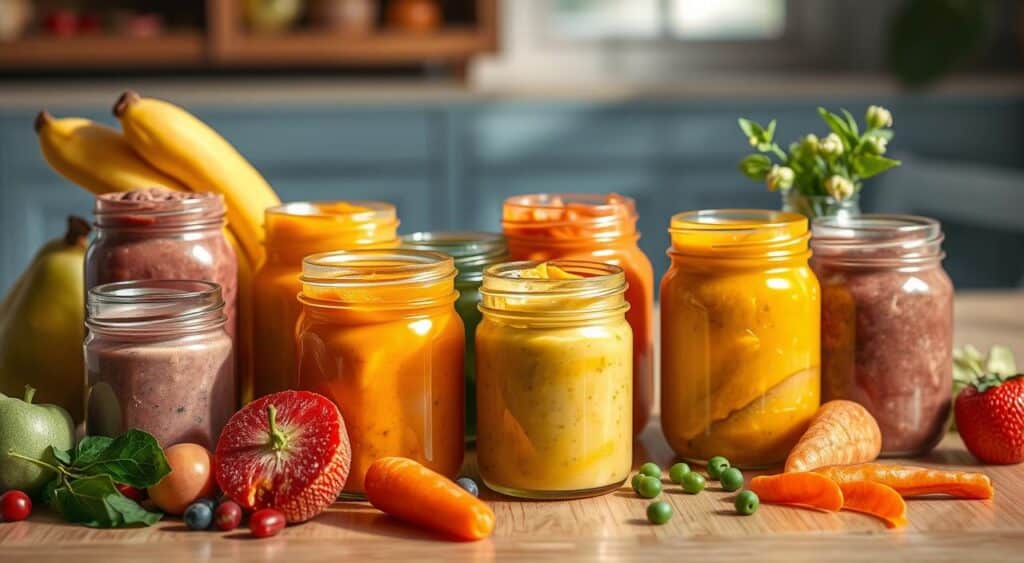Jump to:
Estimated reading time: 12 minutes
Table of contents
Starting your baby on solid foods is both thrilling and challenging. There are many choices, from purees and single-grain cereals to mashed foods and finger foods. This guide will cover the 5 key types of baby food that are vital for your child’s nutrition and growth.
Choosing between homemade, organic, or commercial baby food is important. Knowing when to introduce different foods helps ensure a balanced diet. Offering a variety of nutrient-rich foods supports your baby’s healthy development.
5 types of baby food? Key Takeaways
- Discover the 5 essential types of baby food: purees, single-grain cereals, mashed foods, finger foods, and combination foods.
- Learn when to introduce each type of baby food and how to safely transition between them.
- Understand the importance of offering a variety of nutrient-rich options to support your baby’s development.
- Explore the benefits of homemade, organic, and commercial baby food options.
- Avoid common mistakes when introducing different types of baby food.
Introduction
Starting your baby on solid foods is a big step for new parents. It’s exciting but can feel overwhelming. Knowing the 5 main types of baby food and how to introduce them is key. This guide will help you understand these baby food types and offer tips for this important time.
The American Academy of Pediatrics says to start solid foods around 6 months old. Don’t introduce foods before 4 months old. Most kids can start eating solids at 6 months old. By 7 or 8 months old, they can eat a variety of foods.
Some foods, like cow’s milk products and nuts, should be introduced carefully. This is especially true for kids with allergies or severe eczema. Always check with your pediatrician before introducing these foods.
As you start introducing solid foods, let’s look at the 5 types of baby food. We’ll explore the best ways to make this transition smooth and healthy for your baby.
Understanding the Different Types of Baby Food
As your little one grows, introducing a variety of nutrient-rich foods is crucial for their development. The American Academy of Pediatrics recommends starting solid foods around 6 months of age. This is when your baby shows signs of readiness, such as sitting upright and controlling their head and neck.
Why Offering Variety is Important for Baby’s Nutrition
Offering a diverse range of baby food types is key. This includes purees, cereals, finger foods, and combination foods. It helps your baby develop a well-rounded palate and ensures they get all the essential nutrients for growth. This approach also promotes the development of important oral and swallowing skills.
When to Start Introducing Solid Foods
The American Academy of Pediatrics suggests introducing solid foods between 4 and 6 months of age. This is based on your baby’s cues and developmental milestones. It’s recommended to introduce one new single-ingredient food every 3 days to monitor for any allergic reactions.
How to Transition Between Food Types
As your baby grows, you’ll need to gradually transition from smooth purees to more textured mashed foods and eventually finger foods. This gradual progression helps your baby develop the necessary skills to safely navigate a wider range of solid foods. By 8 months old, babies can typically start trying potential allergen foods like peanuts, tree nuts, eggs, and fish.

“Introducing a variety of foods early on helps expand your baby’s palate and exposes them to different textures, tastes, and nutrients essential for their growth and development.”
| Baby’s Age | Recommended Foods |
|---|---|
| 4-6 months | Iron-fortified infant cereals, pureed fruits and vegetables |
| 6-8 months | Mashed or soft-cooked fruits and vegetables, soft-cooked meat, poultry, fish, eggs, and beans |
| 8-12 months | Finger foods like small pieces of soft fruits, vegetables, pasta, and bread |
By gradually introducing a variety ofbaby food types, you can ensure your little one receives all the necessary nutrients for their optimal growth and development.
5 types of baby food? Type 1: Purees
Purees are a common first food for babies. They are easy to swallow and digest. Fruits and vegetables purees like apples, bananas, sweet potatoes, and peas are full of nutrients. They have a smooth texture that’s perfect for starting solid foods.
Homemade vs. Store-Bought Purees: What’s Best?
Store-bought purees are convenient, but homemade ones let you choose what goes in. You can adjust the texture for your baby’s age and needs. Start with small amounts and increase as your baby gets used to eating solids.
How to Introduce Purees Based on Age and Stage
- Stage 1 Baby Food (4-6 months): A watery puree of a single ingredient, like sweet potato or carrot.
- Stage 2 Baby Food (6-9 months): Thicker, strained or mashed, with spices for flavor.
- Stage 3 Baby Food (10-12 months): Mushy but chunkier, with small, easy-to-chew pieces.
Introduce one new food every 3-5 days to watch for allergic reactions. Common allergens like dairy, eggs, and peanuts should be introduced after safer foods.

“Purees are a great way to introduce your baby to solid foods, as they are easy to swallow and digest. By making homemade purees, you can control the ingredients and customize the texture to your baby’s needs.”
5 types of baby food? Type 2: Single-Grain Baby Cereals
Single-grain baby cereals, like rice, oats, or barley, are a common first food for babies. They are packed with nutrients and often have added vitamins and minerals. Iron is especially important for babies around 6 months old.
Rice, Oat, and Barley Cereals for Iron Intake
The American Academy of Pediatrics suggests trying different cereals to avoid heavy metals like arsenic. Babies lose their iron stores by 6 months. So, it’s key to include single-grain baby cereals in their diet for iron.
When and How to Introduce Baby Cereals
Start with small amounts of baby cereals and slowly increase the amount. This helps your baby’s stomach get used to the new food.
Mixing Cereals with Breast Milk or Formula for Smooth Texture
Mixing cereals with breast milk or formula makes them smooth and easy to swallow. It also helps your baby get the nutrients they need from both the cereal and their milk.
“Providing a mix of homemade and store-bought baby cereals can offer variety in flavor and nutrients for your little one.”
5 types of baby food? Type 3: Mashed Foods
It’s time to move from smooth purees to mashed foods with a thicker texture. This change helps your baby learn to chew and swallow. Good choices include avocado, banana, and sweet potatoes.
Transitioning from Purees to Mashed Foods
Babies usually start eating Stage 3 mashed foods at 9 months. They’ve already tried smoother and single-ingredient purees. This step introduces new textures and tastes, helping with chewing.
Ideal Mashed Foods: Avocado, Banana, and Sweet Potatoes
Choose nutrient-rich foods like avocado, banana, and sweet potatoes for mashed foods. These soft foods offer vitamins, minerals, and healthy fats. They support your baby’s growth and health.
How to Add Protein-Rich Foods to Mashed Foods
To add protein, mix in protein-rich foods like mashed chicken, pork, or beans. This adds nutrients and helps your baby get used to different tastes and textures.
“Babies typically start consuming stage 3 foods around 9 months old, after having tried smoother and single-ingredient purees.”
| Food Type | Age Range | Texture |
|---|---|---|
| Stage 1 Baby Foods | 6 months | Single-ingredient pureed foods |
| Stage 2 Baby Foods | 7-8 months | Multiple ingredients in thicker mashed or strained foods, including meats |
| Stage 3 Mashed Foods | 9-12 months | Small chunks and finger foods to aid in developing chewing skills |
5 types of baby food? Type 4: Finger Foods
As your baby grows, you can introduce finger foods. These foods help them practice self-feeding and improve their dexterity. They also expose your baby to different tastes and textures, supporting their growth and development.
Safe Finger Foods for Babies Starting to Self-Feed
Choose soft, bite-sized pieces for your baby’s finger foods. These should be easy to grasp and chew. Good options include:
- Soft, ripe fruits like bananas, peaches, and berries
- Cooked, tender vegetables such as sweet potatoes, green beans, and carrots
- Cooked, soft pasta pieces
Best Finger Foods: Soft Fruits, Vegetables, and Cooked Pasta
Focus on soft, nutrient-rich finger foods. Soft fruits like bananas, peaches, and berries are great. So are cooked, tender vegetables like sweet potatoes, green beans, and carrots. Cooked, soft pasta pieces are also good as your baby learns to chew and swallow.
How to Monitor and Prevent Choking with Finger Foods
It’s important to prevent choking with finger foods. Always watch your baby during meals. Make sure the food is cut into small pieces (about 1/2 inch or smaller). Avoid foods that are high choking risks, like grapes, hot dogs, and raw vegetables. Also, keep your baby in a high chair to reduce choking risks.
| Recommended Finger Foods | Foods to Avoid |
|---|---|
|
|
Introduce a variety of safe, nutritious finger foods. Watch your baby during meals to ensure their safety and promote a balanced diet.
5 types of baby food? Type 5: Combination Foods
As your baby gets used to solid foods, you can start mixing different foods for meals. Try mixing pureed veggies with mashed proteins or soft fruits with cooked grains. This helps your baby try new tastes and textures, making them more adventurous with food.
Combining Multiple Food Types for Balanced Meals
When mixing foods, aim for a mix of nutrients from various groups. For instance, blend sweet potatoes and peas with Greek yogurt for a healthy meal. Or, serve soft pasta, avocado, and shredded chicken for a tasty finger food.
How to Safely Mix Ingredients as Baby Grows
As your baby grows, you can add more ingredients to their meals. Start with two ingredients and then add more. Always watch how your baby reacts and adjust the mix to keep them safe and avoid allergies.
Introducing Herbs and Mild Spices for Flavor Variety
To spice up your baby’s meals, try mild herbs and spices. Herbs like basil, parsley, and dill add fresh flavors. Spices like cinnamon, cumin, and turmeric bring warmth. Start with a little and see how your baby likes it before adding more.
“Introducing a variety of flavors early on can help your baby develop a more adventurous palate and appreciation for diverse cuisines later in life.”
By mixing foods and adding new flavors, you give your baby a balanced diet. This sets them up for a lifetime of healthy eating. With a bit of creativity, mealtimes can be both fun and nutritious for your baby.
Common Mistakes When Introducing Different Types of Baby Food
Starting solid foods is a big step for your baby. But, it’s important to avoid mistakes that can harm their health and growth. These include giving foods that are too hard or spicy too early. Also, not watching for signs of allergies or food sensitivities is a big no-no.
Offering Foods That Are Too Complex Too Soon
Parents often want to give their babies new tastes. But, it’s best to start with simple foods. Experts say to begin with single-ingredient and slowly add more textures and flavors. Rushing this can cause choking and upset stomachs.
Not Following a Proper Transition Plan Between Food Types
Changing from purees to mashed foods and then to finger foods needs a careful plan. Skipping steps or adding new textures too fast can confuse your baby. A gradual plan helps your child get used to new foods smoothly.
Ignoring Signs of Allergies and Food Sensitivities
Every baby reacts differently to new foods. Watch for signs like rashes, irritability, or changes in bowel movements. If you see any of these, talk to your pediatrician and be careful with new foods.
By avoiding these common mistakes, you can make sure your baby’s transition to solid foods is safe and easy. Always listen to your pediatrician and trust your gut when it comes to your baby’s needs.
Frequently Asked Questions: 5 types of baby food?
What are some good first foods for babies?
Good first foods include single-ingredient purees like sweet potato, carrot, banana, and avocado. These foods are gentle on the digestive system and packed with nutrients essential for growth.
When can I start introducing protein-rich foods?
You can begin introducing protein-rich foods around 7-8 months. Good options include pureed chicken, lentils, and Greek yogurt, which provide important nutrients like iron and protein.
Can I combine foods to make baby food more nutritious?
Yes, combining foods adds variety and nutrients. Once babies tolerate single foods, try mixing foods like apple and spinach or banana and oatmeal for a nutritious, balanced meal.
How do I store homemade baby food?
You can store homemade baby food in the refrigerator for up to 3 days or freeze it in ice cube trays for up to 3 months. Freeze small portions to make it easy to thaw just what you need each day.
Conclusion: Ensuring a Balanced Diet with the Right Types of Baby Food
Understanding the 5 main types of baby food is key. These include purees, single-grain cereals, mashed foods, finger foods, and combination dishes. This ensures your baby gets a balanced diet for growth and development.
Start by introducing new foods slowly. Watch for any signs of allergies. Also, adjust the diet as your baby grows and their needs change.
Teaching your baby healthy eating habits from the start is important. Begin with purees and cereals. Then, move to mashed foods, finger foods, and finally, combination dishes.
Offering a variety of foods helps your baby’s body and taste buds. This sets them up for a lifetime of eating well.
Every baby is different, so there’s no single way to feed them. Listen to your baby’s signals and talk to your pediatrician. Be ready to change your feeding plan if needed.
By mixing homemade and commercial baby food, you can give your baby a great start. This helps them develop healthy eating habits for life.






